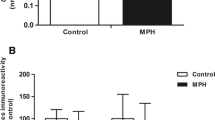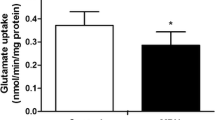Abstract
Studies have shown a relationship between energy metabolism and methylphenidate (MPH); however, there are no studies evaluating the effects of MPH in Krebs cycle. So, we investigated if MPH treatment could alter the activity of citrate synthase (CS), malate dehydrogenase (MD), and isocitrate dehydrogenase (ID) in the brain of young and adult Wistar rats. Our results showed that MPH (2 and 10 mg/kg) reduced CS in the striatum and prefrontal cortex (PF), with MPH at all doses in the cerebellum and hippocampus after chronic treatment in young rats. In adult rats the CS was reduced in the cerebellum after acute treatment with MPH at all doses, and after chronic treatment in the PF and cerebellum with MPH (10 mg/kg), and in the hippocampus with MPH (2 and 10 mg/kg). The ID decreased in the hippocampus and striatum with MPH (2 and 10 mg/kg), and in the cortex (10 mg/kg) after acute treatment in young rats. In adult rats acute treatment with MPH (2 and 10 mg/kg) reduced ID in the cerebellum, and with MPH (10 mg/kg) in the cortex; chronic treatment with MPH (10 mg/kg) decreased ID in the PF; with MPH (2 and 10 mg/kg) in the cerebellum, and with MPH at all doses in the hippocampus. The MD did not alter. In conclusion, our results suggest that MPH can alter enzymes of Krebs cycle in brain areas involved with circuits related with attention deficit hyperactivity disorder; however, such effects depend on age of animal and treatment regime.



Similar content being viewed by others
References
Arnsten AF (2006) Fundamentals of attention-deficit/hyperactivity disorder: circuits and pathways. J Clin Psychiatry 67:7–12
Berman SB, Hastings TG (1999) Dopamine oxidation alters mitochondrial respiration and induces permeability transition in brain mitochondria: implications for Parkinson’s disease. J Neurochem 73:1127–1137
Bertoni-Freddari C, Mocchegiani E, Malavolta M, Casoli T, Di Stefano G, Fattoretti P (2006) Synaptic and mitochondrial physiopathologic changes in the aging nervous system and the role of zinc ion homeostasis. Mech Ageing Dev 127:590–596
Biederman J (2005) Attention-deficit/hyperactivity disorder: a selective overview. Biol Psychiatry 57(11):1215–1220
Bubber P, Hartounian V, Gibson GE, Blass JP (2011) Abnormalities in the tricarboxylic acid (TCA) cycle in the brains of schizophrenia patients. Eur Neuropsychopharmacol 21:254–260
Burrone J, Murthy VN (2003) Synaptic gain control and homeostasis. Curr Opin Neurobiol 13:560–567
Ceylan M, Sener S, Bayraktar AC, Kavutcu M (2010) Oxidative imbalance in child and adolescent patients with attention-deficit/hyperactivity disorder. Prog Neuropsychopharmacol Biol Psychiatry 34:1491–1494
Chase TD, Carrey N, Soo E, Wilkinson M (2007) Methylphenidate regulates activity regulated cytoskeletal associated but not brain-derived neurotrophic factor gene expression in the developing rat striatum. Neuroscience 144:969–984
Claussen C, Dafny N (2012) Acute and chronic methylphenidate modulates the neuronal activity of the caudate nucleus recorded from freely behaving rats. Brain Res Bull 87:387–396
Fagundes AO, Rezin GT, Zanette F, Grandi E, Assis LC, Dal-Pizzol F, Quevedo J, Streck EL (2007) Chronic administration of methylphenidate activates mitochondrial respiratory chain in brain of young rats. Int J Dev Neurosci 25:47–51
Fagundes AO, Aguiar MR, Aguiar CS, Scaini G, Sachet MU, Bernhardt NM, Rezin GT, Valvassori SS, Quevedo J, Streck EL (2010a) Effect of acute and chronic administration of methylphenidate on mitochondrial respiratory chain in the brain of young rats. Neurochem Res 35:1675–1680
Fagundes AO, Scaini G, Santos PM, Sachet MU, Bernhardt NM, Rezin GT, Valvassori SS, Schuck PF, Quevedo J, Streck EL (2010b) Inhibition of mitochondrial respiratory chain in the brain of adult rats after acute and chronic administration of methylphenidate. Neurochem Res 35:405–411
Feier G, Valvassori SS, Lopes-Borges J, Varela RB, Bavaresco DV, Scaini G, Morais MO, Andersen ML, Streck EL, Quevedo J (2012) Behavioral changes and brain energy metabolism dysfunction in rats treated with methamphetamine or dextroamphetamine. Neurosci Lett 530:75–79
Froehlich TE, Lanphear BP, Epstein JN, Barbaresi WJ, Katusic SK, Kahn RS (2007) Prevalence, recognition, and treatment of attention-deficit/hyperactivity disorder in a national sample of US children. Arch Pediatr Adolesc Med 161:857–864
Gluck MR, Zeevalk GD (2004) Inhibition of brain mitochondrial respiration by dopamine and its metabolites: implications for Parkinson’s disease and catecholamine-associated diseases. J Neurochem 91:788–795
Gluck M, Ehrhart J, Jayetilleke E, Zeevalk GD (2002) Inhibition of brain mitochondrial respiration by dopamine: involvement of H2O2 and hydroxyl radicals but not glutathione-protein-mixed disulfides. J Neurochem 82:66–74
Gomes KM, Inácio CG, Valvassori SS, Réus GZ, Boeck CR, Dal-Pizzol F, Quevedo J (2009) Superoxide production after acute and chronic treatment with methylphenidate in young and adult rats. Neurosci Lett 465:95–98
Gomes KM, Comim CM, Valvassori SS, Réus GZ, Inácio CI, Martins MR, Souza RP, Quevedo J (2010) Diurnal differences in memory and learning in young and adult rats treated with methylphenidate. J Neural Transm 117:457–462
Gomes KM, Souza TP, Inácio CI, Valvassori SS, Réus GZ, Martins MR, Comim CM, Quevedo J (2011) Evaluation of light/dark cycle in anxiety- and depressive-like behaviors after regular treatment with methylphenidate hydrochloride in rats of different ages. Rev Bras Psiquiatr 33:55–58
Guemouri L, Artur Y, Herbeth B, Jeandel C, Cuny G, Siest G (1991) Biological variability of superoxide dismutase, glutathione peroxidase, and catalase in blood. Clin Chem 37:1932–1937
Hannestad J, Gallezot JD, Planeta-Wilson B, Lin SF, Williams WA, van Dyck CH, Malison RT, Carson RE, Ding YS (2010) Clinically relevant doses of methylphenidate significantly occupy norepinephrine transporters in humans in vivo. Biol Psychiatry 68:854–860
Houghton S, Alsalmi N, Tan C, Taylor M, Durkin K (2013) Treating comorbid anxiety in adolescents with ADHD using a cognitive behavior therapy program approach. J Atten Disord (in press)
Hroudova J, Fisar Z (2010) Activities of respiratory chain complexes and citrate synthase influenced by pharmacologically different antidepressants and mood stabilizers. Neuro Endocrinol Lett 31:336–342
Kessler RC, Adler L, Barkley R, Biederman J, Conners CK, Demler O, Faraone SV, Greenhill LL, Howes MJ, Secnik K, Spencer T, Ustun TB, Walters EE, Zaslavsky AM (2006) The prevalence and correlates of adult ADHD in the United States: results from the National Comorbidity Survey Replication. Am J Psychiatry 163:716–723
Kilbride SM, Telford JE, Davey GP (2008) Age-related changes in H2O2 production and bioenergetics in rat brain synaptosomes. Biochim Biophys Acta 1777:783–788
Kitto GB (1969) Intra- and extramitochondrial malate dehydrogenases from chicken and tuna heart. Methods Enzymol 13:106–116
Kuczenski R, Segal DS (2005) Stimulant actions in rodents: implications for attention-deficit/hyperactivity disorder treatment and potential substance abuse. Biol Psychiatry 57:1391–1396
Li Q, Lu G, Antonio GE, Mak YT, Rudd JA, Fan M, Yew DT (2007) The usefulness of the spontaneously hypertensive rat to model attention-deficit/disorder (ADHD) may be explained by the differential expression of dopamine-related genes in the brain. Neurochem Int 50:848–857
Lowry OH, Rosebrough NJ, Farr AL, Randall RJ (1951) Protein measurement with the Folin phenol reagent. J Biol Chem 193:265–275
Mague SD, Andersen SL, Carlezon WA Jr (2005) Early developmental exposure to methylphenidate reduces cocaine-induced potentiation of brain stimulation reward in rats. Biol Psychiatry 57:120–125
Marazziti D, Baroni S, Picchetti M, Landi P, Silvestri S, Vatteroni E, Catena Dell’Osso M (2012) Psychiatric disorders and mitochondrial dysfunctions. Eur Rev Med Pharmacol Sci 16:270–275
Martins MR, Reinke A, Petronilho FC, Gomes KM, Dal-Pizzol F, Quevedo J (2006) Methylphenidate treatment induces oxidative stress in young rat brain. Brain Res 1078:189–197
Nestler EJ (2004) Molecular mechanisms of drug addiction. Neuropharmacology 47:24–32
Nierenberg AA, Miyahara S, Spencer T, Wisniewski SR, Otto MW, Simon N, Pollack MH, Ostacher MJ, Yan L, Siegel R, Sachs GS (2005) Clinical and diagnostic implications of lifetime attention-deficit/hyperactivity disorder comorbidity in adults with bipolar disorder: data from the first 1000 STEP-BD participants. Biol Psychiatry 57:1467–1473
Paxinos G, Watson C (1986) The rat brain: stereotaxic coordinates, 2nd edn. Academic, Australia
Plaut GWE (1969) Isocitrate dehydrogenases from bovine heart. Methods Enzymol 13:34–42
Scaini G, Fagundes AO, Rezin GT, Gomes KM, Zugno AI, Quevedo J, Streck EL (2008) Methylphenidate increases creatine kinase activity in the brain of young and adult rats. Life Sci 83:795–800
Scheffler IE (2008) Mitochondria, 2nd edn. Hoboken, USA
Schmitz F, Scherer EB, da Cunha MJ, da Cunha AA, Lima DD, Delwing D, Netto CA, Wyse AT (2012) Chronic methylphenidate administration alters antioxidant defenses and butyrylcholinesterase activity in blood of juvenile rats. Mol Cell Biochem 361:281–288
Souza RP, Soares EC, Rosa DVF, Souza BR, Réus GZ, Barichello T, Gomes KM, Gomez MV, Quevedo J, Romano-Silva MA (2008) Methylphenidate alters NCS-1 expression in rat brain. Neurochem Int 53:12–16
Srere PA (1969) Citrate synthase. In: Lowenstein JM (ed) Methods in enzymology, citric acid cycle. Academic, New York, pp 3–11
Surmeier DJ, Ding J, Day M, Wang Z, Shen W (2007) D1 and D2 dopamine-receptor modulation of striatal glutamatergic signaling in striatal medium spiny neurons. Trends Neurosci 30:228–235
Valentine JS, Wertz DL, Lyons TJ, Liou LL, Goto JJ, Gralla EB (1998) The dark side of dioxygen biochemistry. Curr Opin Chem Biol 2:253–262
Visser SN, Lesesne CA, Perou R (2007) National estimates and factors associated with medication treatment for childhood attention-deficit/hyperactivity disorder. Pediatrics 119:99–106
Volkow ND, Fowler JS, Wang G, Ding Y, Gatley SJ (2002) Mechanism of action of methylphenidate: insights from PET imaging studies. J Atten Disord 6:31–43
Volkow ND, Wang GJ, Fowler JS, Ding YS (2005) Imaging the effects of methylphenidate on brain dopamine: new model on its therapeutic actions for attention deficit/hyperactivity disorder. Biol Psychiatry 57:1410–1415
Wilens TE, Biederman J (1992) The stimulants. Psychiatr Clin North Am 15:191–222
Acknowledgments
This study was supported in part by grants from “Conselho Nacional de Desenvolvimento Científico e Tecnológico” (CNPq-Brazil–JQ and ELS), from the Instituto Cérebro e Mente (JQ), UNESC (JQ and ELS), Fundação de Amparo à Pesquisa e Inovação do Estado de Santa Catarina (FAPESC–JQ), and Coordenação de Aperfeiçoamento de Pessoal de Nível Superior (CAPES–ELS). JQ and ELS are recipients of CNPq Productivity Fellowships. GZR and GS are holders of a CAPES studentship.
Author information
Authors and Affiliations
Corresponding author
Rights and permissions
About this article
Cite this article
Réus, G.Z., Scaini, G., Furlanetto, C.B. et al. Methylphenidate Treatment Leads to Abnormalities on Krebs Cycle Enzymes in the Brain of Young and Adult Rats. Neurotox Res 24, 251–257 (2013). https://doi.org/10.1007/s12640-013-9383-6
Received:
Revised:
Accepted:
Published:
Issue Date:
DOI: https://doi.org/10.1007/s12640-013-9383-6




